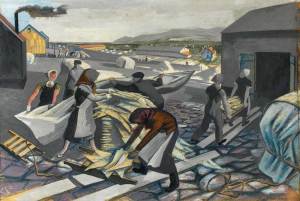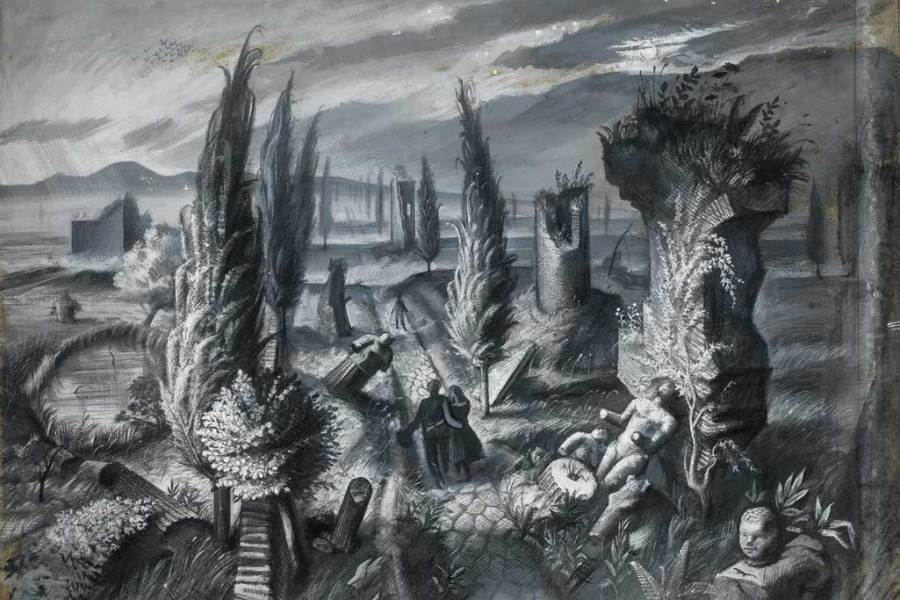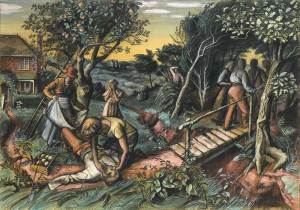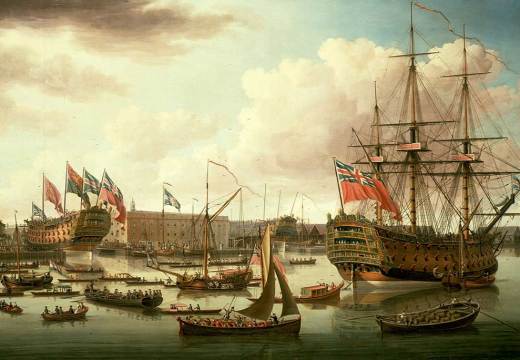Now and again, tiring of ingenious conceptualism, or aching from an art fair’s endless plywood corridors, there comes a yearning for a time when beauty was taken seriously. We become, in short, Romantics. As the dust settles from Frieze, there’s no better time to trudge through the falling leaves of Lincoln’s Inn Fields to that temple to ideal forms, Sir John Soane’s Museum, which is currently holding the first major survey of the work of the neo-Romantic artist Alan Sorrell (1904–1974).
Known largely for his painted reconstructions of archaeological sites, Sorrell’s rigorous training in ancient and Renaissance art equipped him with an extraordinary assurance of vision, tempered by an imaginative delight in narrative. As a counterpoint to his interest in historical reconstruction, Sorrell’s typically Romantic preoccupation with ruins can be seen in paintings such as The Artist in the Campagna (1931), or the melodramatic moonlit scenes on the Appian Way. The sinister domesticity of The Long Journey (1936) reveals a darker sensibility in its gnarled and mannered composition, while in paintings such as Processing the Catch (1935) Sorrell comes into his own with a dynamic animation of working figures, further demonstrated in Men Sandbagging (1939).
The exhibition also includes panels from Sorrell’s mural commissioned for the 1951 Festival of Britain, Working Boats from Around the British Coast, where a jaunty scene complete with doe-eyed mermaids and a dancing lobster seems worlds away from the stark, linear visions of RAF bases from his war years. Writing to the War Artists Advisory Committee in 1940, he described his experience with the earnestness of a bespectacled schoolboy dissecting a beetle: ‘I’ve seen, and am seeing, some jolly good things to make pictures of, and am memorising a good deal and getting it on paper in quite a precise way.’
The neo-Romantic idiom was essentially government-friendly; presenting an England that people could yearn for, and would fight for. However, unlike fellow artists such as John Piper, whose depiction of the bombed-out Coventry Cathedral has become a defining image of the Blitz, Sorrell refused to represent the destruction of sites he deemed of ‘irreplaceable artistic importance’ – a stand he described as his ‘one man mutiny’. While slow decay is ripe with possibilities for Romantic melancholy, the sudden act of ruination is simply barbaric.

Processing the Catch, Wharf Scene, Iceland (c. 1935), Alan Sorrell Courtesy of the Trustees of Sir John Soane’s Museum
British neo-Romanticism comes into fashion every few decades, when narrative, figuration and lightly-veiled idealism act as an antidote to excessive theorising. In 1987, the heyday of yuppies and diet fads, the Barbican staged ‘A Paradise Lost: The Neo-Romantic Imagination in Britain 1935–1955’.
Over the last few years, neo-Romanticism has returned, with exhibitions including the Dulwich Picture Gallery’s Paul Nash show in 2010, Graham Sutherland curated by George Shaw at Modern Art Oxford, and Pallant House Gallery’s parallel exhibitions of Robert Ironside and Keith Vaughan last year. Alexandra Harris’ bestseller Romantic Moderns caught the zeitgeist, and John Piper’s work has been the subject of numerous exhibitions across the country, ranging from his depictions of the mountains of Wales to the churches of Sussex. Liss Fine Art continues to be an important advocate for British art of the period, and is the force behind this exhibition, presenting several unseen works from the Sorrell family collection.
Sorrell’s work can seem guarded, steeped in a scrupulousness that can be difficult for today’s gallery goers, used to unmade beds and stuffed socks. After Jeremy Deller’s The Battle of Orgreave (2001) the reconstruction paintings seem comparatively naive in their simple dedication to concretising a historical moment. However, in the context of the Soane Museum, Sorrell’s work achieves its full imaginative force. Ascending the sweeping spiral staircase, sparingly lit by the vertiginous glass dome several floors above, we allow ourselves to be drawn into the museum’s delight in its own drama, its inherent force of enquiry. In banishing the cynicism necessary for modern living, we are invited into Sorrell’s world.
‘Alan Sorrell: A Life Reconstructed’ is at Sir John Soane’s Museum until 25 January 2014.
Unlimited access from just $16 every 3 months
Subscribe to get unlimited and exclusive access to the top art stories, interviews and exhibition reviews.















![Masterpiece [Re]discovery 2022. Photo: Ben Fisher Photography, courtesy of Masterpiece London](http://www.apollo-magazine.com/wp-content/uploads/2022/07/MPL2022_4263.jpg)
Has the Fitzwilliam got its rehang right?